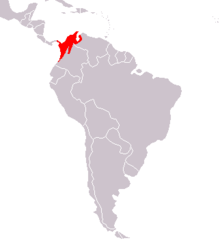
The capybara or greater capybara is a giant cavy rodent native to South America. It is the largest living rodent and a member of the genus Hydrochoerus. The only other extant member is the lesser capybara. Its close relatives include guinea pigs and rock cavies, and it is more distantly related to the agouti, the chinchilla, and the nutria. The capybara inhabits savannas and dense forests, and lives near bodies of water. It is a highly social species and can be found in groups as large as 100 individuals, but usually live in groups of 10–20 individuals. The capybara is hunted for its meat and hide and also for grease from its thick fatty skin. It is not considered a threatened species.

Caviidae, the cavy family, is composed of rodents native to South America and includes the domestic guinea pig, wild cavies, and the largest living rodent, the capybara. They are found across South America in open areas from moist savanna to thorn forests or scrub desert. This family of rodents has fewer members than most other rodent families, with 19 species in 6 genera in 3 subfamilies.
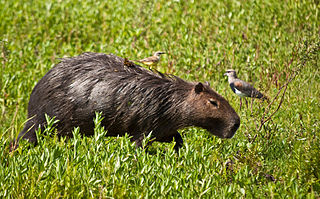
The genus Hydrochoerus contains two living and three extinct species of rodents from South America, the Caribbean island of Grenada, California and Panama. Capybaras are the largest living rodents in the world. The genus name is derived from the Greek ὕδωρ 'water' plus χοίρος 'pig'.
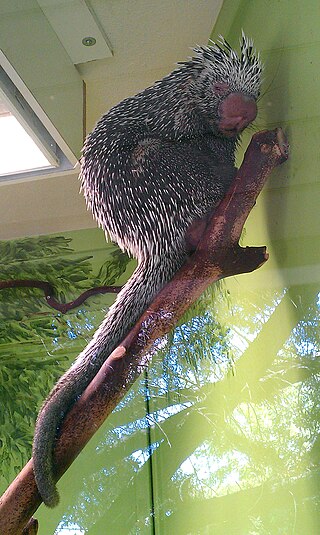
The prehensile-tailed porcupines or coendous are found in Central and South America. Two other formerly recognized Neotropical tree porcupine genera, Echinoprocta and Sphiggurus, have been subsumed into Coendou, since Sphiggurus was shown by genetic studies to be polyphyletic, while Echinoprocta nested within Coendou.

Hydrochoerinae is a subfamily of Caviidae, consisting of two living genera, Hydrochoerus, the capybaras, and Kerodon, the rock cavies. In addition, a number of extinct genera related to capybaras should also be placed in this subfamily. The taxonomy of Hydrochoerinae is confused because, until 2005, living capybaras and their extinct relatives were placed in their own family, Hydrochoeridae. Recent molecular phylogenetic studies recognize a close relationship between Hydrochoerus and Kerodon, supporting placement of both genera in a subfamily of Caviidae. Paleontological classifications have yet to incorporate this new taxonomy, and continue to use Hydrochoeridae for all capybaras, while using Hydrochoerinae for the living genus and its closest fossil relatives such as Neochoerus. The taxonomy of fossil hydrochoerines is also in a state of flux. In recent years, the diversity of fossil hydrochoerines has been substantially reduced. This is largely due to the recognition that capybara molar teeth show strong variation in shape over the life of an individual. In one instance, material once referred to four genera and seven species on the basis of differences in molar shape is now thought to represent differently aged individuals of a single species, Cardiatherium paranense.

Fischer's guiara, is a spiny rat species found in Argentina, Brazil and Paraguay. It is one of only two species in the genus Euryzygomatomys. Its karyotype has 2n=46 and FN=88.
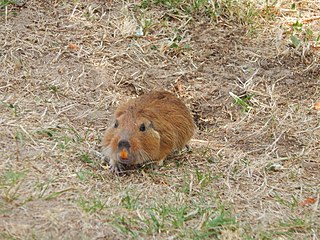
Pearson's tuco-tuco is a species of rodent in the family Ctenomyidae. It is endemic to Uruguay, where it is found at elevations below 200 m. This tuco-tuco constructs burrows with multiple openings containing one to two nests of dried grass; it prefers areas of sandy soil but is somewhat adaptable. It is threatened by loss of habitat to development, agriculture and ranching. Multiple karyotypes have been reported, including 2n = 68–70, FN = 80–88, as well as 2n = 56, FN = 77–79, suggesting the taxon may represent several species. C. dorbignyi appears to be cytogenetically indistinguishable from the 2n = 70 form. The species is named after American zoologist Oliver Payne Pearson.
The frosted hairy dwarf porcupine is a porcupine species in the family Erethizontidae from Colombia and northern and eastern Venezuela. It was formerly sometimes assigned to Sphiggurus, a genus no longer recognized since genetic studies showed it to be polyphyletic. The species lives in lowland tropical rainforest and cloud forest at elevations from 50 to 2,600 meters. Its karyotype has 2n = 42 and FN = 76. Its closest relative is the brown hairy dwarf porcupine.

D'Orbigny's tuco-tuco is a species of rodent in the family Ctenomyidae, named after French naturalist Alcide d'Orbigny. It is found in northeast Argentina. Its karyotype has 2n = 70, FN = 84–88, which is cytogenetically indistinguishable from some populations of C. pearsoni; the latter taxon may actually represent several species.
The Lago Blanco tuco-tuco is a species of rodent in the family Ctenomyidae. It is known only from the Lago Blanco area in southern Argentina. Its karyotype has 2n = 28 and FN = 42.

Flamarion's tuco-tuco or the tuco-tuco of the dunes is a rodent species of the family Ctenomyidae Its karyotype has 2n = 48 and FN = 50–78. found in coastal dunes of Rio Grande do Sul state, southern Brazil. The species is threatened by habitat loss due to dune removal and urbanization. It is named after Brazilian biologist Luiz Flamarion B. de Oliveira.
Goodfellow's tuco-tuco is a species of rodent in the family Ctenomyidae. It is endemic to Bolivia, where it is found in the Chiquitano dry forest ecoregion, bordering on the cerrado. Its karyotype has 2n = 46 and FN = 68. The species is named after British collector Walter Goodfellow.
The Pilar tuco-tuco is a species of rodent in the family Ctenomyidae. It is found in Ñeembucú and Misiones Departments in southern Paraguay, east of the city of Pilar. The species lives in areas with sandy soil. It is present in a few isolated populations and is threatened by conversion of its habitat to agriculture and its treatment as a pest. Its karyotype has 2n = 48 or 50 and FN = 50.
Pundt's tuco-tuco is a species of rodent in the family Ctenomyidae. It is endemic to the Pampas of southern Córdoba and San Luis Provinces in central Argentina. The species is named after Argentine landowner and collector Moritz Pundt. It has a fragmented population and is threatened by conversion of its habitat to agricultural use.
Roig's tuco-tuco is a species of rodent in the family Ctenomyidae. It is endemic to a small region near the Paraná River in Corrientes Province, northeastern Argentina, where lives on sand dunes, and near rivers. Development is degrading and shrinking this habitat, threatening the rodent's survival. The species is named after Argentine zoologist Virgilio G. Roig. Its karyotype has 2n = 48 and FN = 80.
Scaglia's tuco-tuco is a species of rodent in the family Ctenomyidae. It is endemic to a locality in Tucumán Province, northern Argentina. The species is named after Argentine naturalist Galileo Juan Scaglia (1915–1989). Its karyotype has 2n = 36 and FN = 64.

Yolanda's tuco-tuco is a species of rodent in the family Ctenomyidae. The species is endemic to Santa Fe Province, northeast Argentina, where it lives near the Paraná and San Javier rivers. Its karyotype has 2n = 50 and FN = 78. It is named after Argentine biologist Yolanda Davis.

The highlands punaré is a caviomorph rodent of South America from the spiny rat family. It is endemic to gallery forest, savanna and rocky outcrop habitats in Bahia State within the Caatinga ecoregion of eastern Brazil at elevations from 260 m to 1030 m. It sometimes nests and often takes refuge in crevices in rock formations, as means of both predator avoidance and moderating temperature extremes. The species tolerates a degree of habitat disturbance. Although hunted, it is considered common throughout its range. Its karyotype has 2n = 26 and FN = 48.
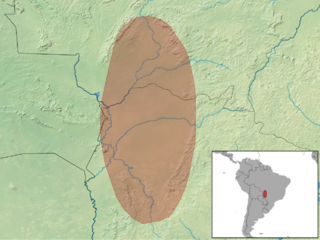
The Paraguayan punaré is a caviomorph rodent of South America from the spiny rat family. With its skull averaging 55 mm long, it is the largest species in the genus Thrichomys. It is found in savannas and forest edges in southwestern Brazil and northern Paraguay within the cerrado ecoregion. The species tolerates a degree of habitat disturbance, and is considered abundant throughout its range.
Hydrochoerus gaylordi is an extinct species of capybara that lived in Grenada during the Late Pliocene to Early Pleistocene. This species was found in 1991 by Ronald Singer and his colleagues based on a maxilla bearing 3 molars, but it was not named until 2000. It may be invalid and a synonym of the extant greater capybara.

